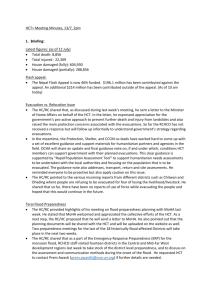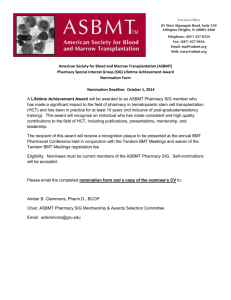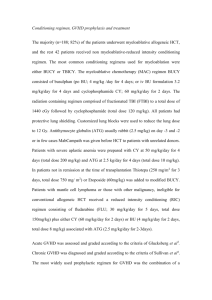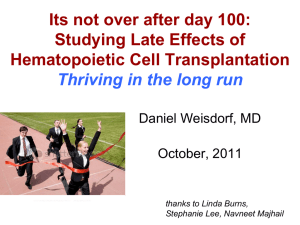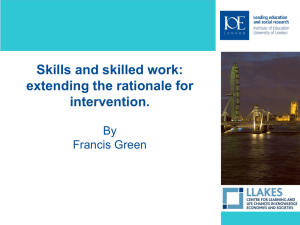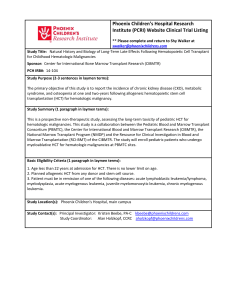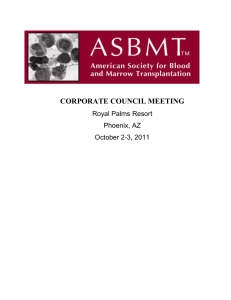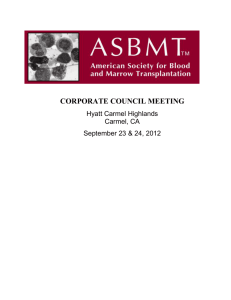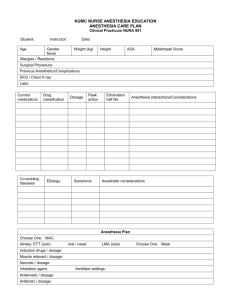ASBMT Research Priorities 2008 - American Society for Blood and
advertisement
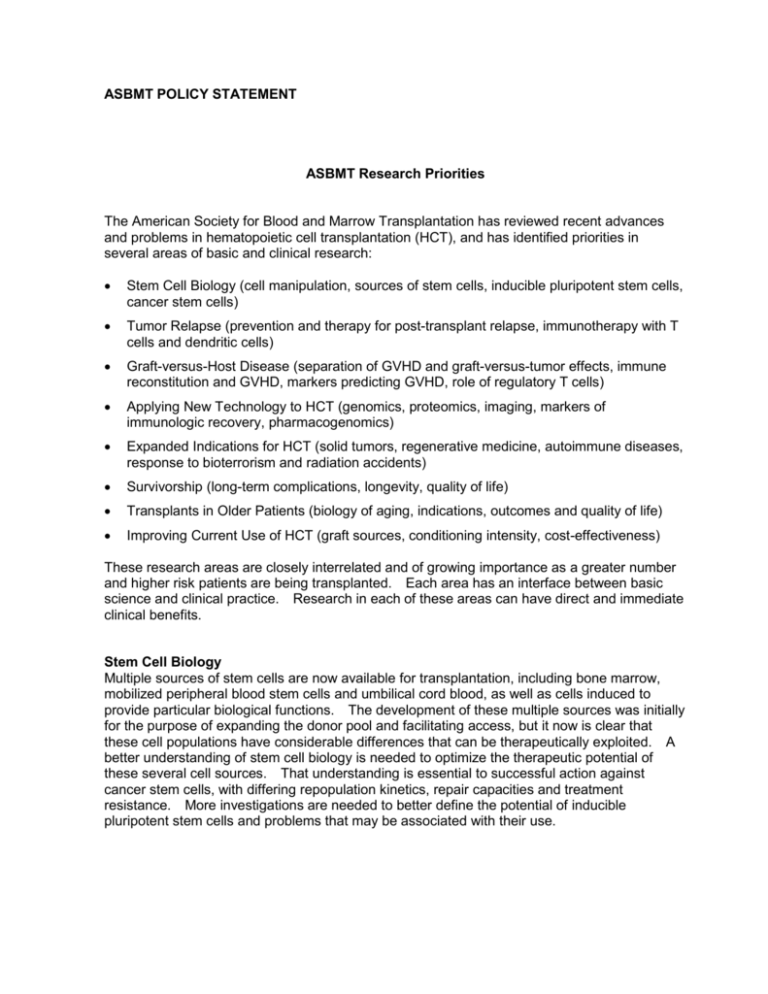
ASBMT POLICY STATEMENT ASBMT Research Priorities The American Society for Blood and Marrow Transplantation has reviewed recent advances and problems in hematopoietic cell transplantation (HCT), and has identified priorities in several areas of basic and clinical research: Stem Cell Biology (cell manipulation, sources of stem cells, inducible pluripotent stem cells, cancer stem cells) Tumor Relapse (prevention and therapy for post-transplant relapse, immunotherapy with T cells and dendritic cells) Graft-versus-Host Disease (separation of GVHD and graft-versus-tumor effects, immune reconstitution and GVHD, markers predicting GVHD, role of regulatory T cells) Applying New Technology to HCT (genomics, proteomics, imaging, markers of immunologic recovery, pharmacogenomics) Expanded Indications for HCT (solid tumors, regenerative medicine, autoimmune diseases, response to bioterrorism and radiation accidents) Survivorship (long-term complications, longevity, quality of life) Transplants in Older Patients (biology of aging, indications, outcomes and quality of life) Improving Current Use of HCT (graft sources, conditioning intensity, cost-effectiveness) These research areas are closely interrelated and of growing importance as a greater number and higher risk patients are being transplanted. Each area has an interface between basic science and clinical practice. Research in each of these areas can have direct and immediate clinical benefits. Stem Cell Biology Multiple sources of stem cells are now available for transplantation, including bone marrow, mobilized peripheral blood stem cells and umbilical cord blood, as well as cells induced to provide particular biological functions. The development of these multiple sources was initially for the purpose of expanding the donor pool and facilitating access, but it now is clear that these cell populations have considerable differences that can be therapeutically exploited. A better understanding of stem cell biology is needed to optimize the therapeutic potential of these several cell sources. That understanding is essential to successful action against cancer stem cells, with differing repopulation kinetics, repair capacities and treatment resistance. More investigations are needed to better define the potential of inducible pluripotent stem cells and problems that may be associated with their use. Page 2 Tumor Relapse Relapse remains of paramount concern after autologous HCT to treat hematologic malignancies. We need to understand the mechanisms by which cancer cells can resist cytotoxic therapies in autologous HSCT. Use of immune therapies, monoclonal antibodies, molecular targeted agents and chemotherapeutics – alone or in combination – should be explored in the context of HCT. This may also help in applying autologous HCT to a wider spectrum of malignancies. Disease recurrence remains a major problem after allogeneic HCT in which cytotoxic therapy is combined with immunotherapy provided by donor cells. A better understanding of the mechanisms by which cancer cells resist cytotoxic therapy might lead to more effective immunotherapies, be they cellular, humoral or vaccination, or a combination of these. These efforts also should include strategies for patients with minimal residual disease after transplantation who are at a high risk of relapse but who may also be more responsive to immunotherapy. Studies have shown the effective use of adoptive T cell transfer after reduced-intensity conditioning in patients with melanoma. However, adoptive therapy with allogeneic cells also is associated with the risk of GVHD. Therefore, techniques that modify autologous cells so they can be used for tumor antigen-specific immunotherapy might improve efficacy and decrease toxicity. Studies on cell trafficking of immune effector cells may also provide important information on the role of “homing” receptors and how those could be used to design more effective therapy. Graft-versus-Host Disease GVHD is still the most frequent complication after HCT. While the use of reduced-intensity conditioning regimens appears to lower the incidence – and possibly severity – of acute GVHD, there has been little impact on chronic GVHD. We need a better understanding of the pathobiology of chronic GVHD and must find new ways to target it clinically. The identification of early biomarkers and prognostic indicators could be helpful in distinguishing patient populations who might benefit from different preemptive or therapeutic strategies. Rather than broad immunosuppression, targeted approaches and possibly selective immunostimulation should be explored. It is likely that this will lead to more individualized management that considers the underlying disease, conditioning used for transplantation, prior therapy and patient age, among other factors. The role of regulatory T cells, shown to be of central importance for tolerance in animal models, deserves clinical exploration. Natural killer (NK) cells are another effector arm in need of better characterization, both as anti-tumor effectors and as immunodulators. Similarly, NK/T cells and suppressive dendritic cell subsets require investigation of their immunomodulatory effects. Understanding pathways that can distinguish GVHD from the graft -versus -tumor effect and the roles of the various immune cell populations in these processes continue to be of central importance for applying HCT in cancer therapies. Page 3 Applying New Technology to HCT The advent of proteomic and genomics has increased the need to validate potential clinical markers. Such markers have important implications for patient selection, prognosis and treatment. Application of new imaging techniques will not only allow assessment of clinical efficacy and cellular therapy trafficking, but also advance our basic understanding of disease processes. Using proteomics to determine correlative markers for GVHD progression and to identify high-risk patients is of considerable importance. Enzyme polymorphisms are likely relevant for drug metabolism and tissue repair, and a better understanding of these relationships could help tailor conditioning regimens and GVHD prophylaxis. Another critical area is development of immune monitoring parameters that reflect immune competence and recovery, particularly with the increasing use of HCT in older patients. Expanded Indications for HCT HCT is known to induce tolerance and therefore may have a high impact in solid organ transplantation. Studies to use HCT as a method to induce tolerance to a donor solid organ are on-going and have generated significant enthusiasm with the ability to stop immune suppression in these patients. Further studies are needed and encouraged. HCT also may be useful in other therapies including, but not limited to, regenerative medicine (heart disease and others), autoimmunity and restoration of hematopoiesis and immunity in the advent of bioterrorism attack or mass radiological accident. Preclinical and clinical studies of immune reconstitution, tolerance, efficacy and long-term effects will aid in understanding the applicability of HCT in these conditions and situations. Survivorship Some former patients have now been followed for three and four decades after transplantation – cured of their disease, but not necessarily without long-term complications. Patients are dealing with problems such as chronic GVHD, immune deficiency, endocrinologic failure, bone loss and secondary malignancies. Recent data suggest that life expectancy in patients after HCT is shortened by about 30 percent, compared with age -matched controls. Thus, there is a high priority for investigations of risk factors for late complications, development of relevant preclinical models, design of interventional strategies to prevent complications and development of better means of assessing quality of life in long-term survivors. Transplants in Older Patients Older patients, who are an increasingly dominant population with respect to cancer and other diseases, represent unique challenges in biologic understanding and extrapolation of preclinical findings and clinical studies. Toxicities of cytoreductive therapies are heightened in the older patient. Poor immune function in the aged leads to increased susceptibility to opportunistic infections and relapse from the cancer. The science of aging needs to be applied to HCT. There are basic questions about the effects of age on hematopoiesis, immune function and response to insult and stress. These need to be coupled with clinical studies on the effects of age on recovery, outcomes and quality of life and general questions about “gain” versus “loss” that may be associated with HCT. Page 4 Improving Current Use of HCT We need to define the optimal stem cell sources (cord blood, peripheral blood stem cells, bone marrow, and ex vivo expanded stem cell populations) and conditioning intensity as they relate to the treatment of specific diseases. Finally, it must be acknowledged that HCT can be resource intensive and expensive. There is a need for studies of the cost-effectiveness of HCT compared to other therapies for achieving desired outcomes. – Amended by the ASBMT Executive Committee October 20, 2011 ___________________________________________________________________________ The ASBMT Board of Directors and Executive Committee wish to thank the members of the Task Force on Research Priorities that helped with the development of this policy statement: H. Joachim Deeg, MD (chair), John F. DiPersio, MD, PhD, James W. Young, MD, Richard T. Maziarz, MD, Claude Perreault, MD, and David A. Margolis, MD, Robert H. Collins MD. The Board of Directors also wishes to acknowledge the recommendation and encouragement of the ASBMT Corporate Council to develop these research priorities.

